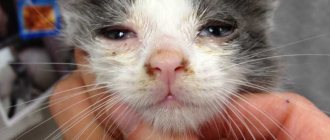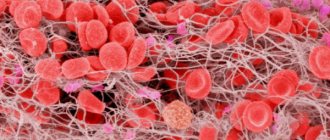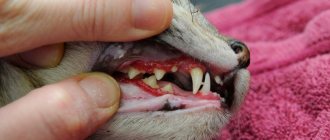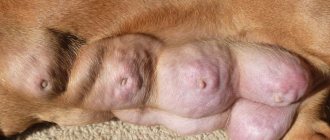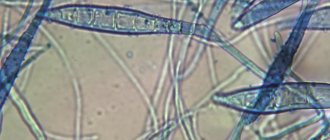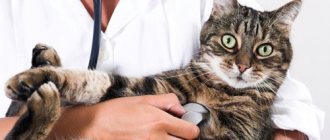Mastopathy is observed quite often in cats. As the disease progresses, the animal's mammary glands increase in size. The disease is considered a precancerous disease and poses a serious threat to the life of the pet. That is why it is important to monitor any changes in the cat’s condition, since it is much easier to cure the pathology in the initial stages.
Gynecomastia in cats is a disease of the male mammary glands, that is, the pathology develops exclusively in males.
What is mastopathy
Mastopathy is an insidious disease that is often confused with mastitis, which develops in animals that feed newborn offspring with breast milk. Many owners believe that if their cat is not a nursing mother, then she is not at risk for mammary gland diseases.
Cats have 4 pairs of mammary glands, the main function of which is to produce and secrete breast milk. Cats also have mammary glands that are in an undeveloped state.
Mastopathy is a disease of the mammary glands, characterized by the growth of atypical tissue in it. The pathology is accompanied by severe pain, thirst and progressive exhaustion. The disease is manifested by general engorgement of the mammary glands, the appearance of small or large nodules, swellings, and bumps.
With the benign nature of the disease, small nodes are enclosed in a connective tissue capsule, due to which atypical cells are prevented from merging with nearby healthy tissues. As the tumor grows, compression of the breast tissue, blood vessels and nerves occurs against a background of severe pain. At this stage, the pathology is successfully treated surgically, and the cat continues to live carefree.
When a benign tumor degenerates into a malignant one, atypical cells grow into healthy tissues and metastasize to lymph nodes and distant organs. It is no longer possible to cure animals with cancerous tumors; life can be extended as much as possible with the help of courses of chemotherapy, hormonal and painkillers. Although sometimes in such a situation it is more humane to euthanize an exhausted pet.
Treatment of mastopathy of oncological etiology
There are physiological mastopathy, when the glands become full before the kittens appear, and pathological mastopathy. In the latter case, the causes of the “prenatal” condition can be viruses, bacteria, and cancer. What to do if symptoms of the disease are detected? Contact a veterinarian, as this pathology is extremely dangerous!
Breast augmentation may well be completely painless. In severe cases, characterized by a rapid increase in volume, the organ acquires a reddish-blue color, becomes hot to the touch, and ulcers form (shown in the photo). The cat experiences severe pain and constantly licks the swollen chest. In many cases, the hind legs may also become swollen. A very serious consequence of mastopathy in this case is the high risk of vein thrombosis. Fortunately, this doesn't happen often. These cats can die suddenly from pulmonary thromboembolism (when a broken blood clot simply blocks the pulmonary arteries). Developing secondary infections can lead to septic shock.
Our cats, the pets that many pamper so much, belong to the family of mammals (like humans themselves). The term consists of two words: “milk” and “nourishing”. The decoding is simple - “milk-feeding”. Not all of them, of course, but only the cubs. Alas, the maternal role is not given to animals for nothing: mastopathy in cats alone annually claims many of the lives of our pets.
If this operation was done between the first and second heat, the likelihood of developing mammary cancer is reduced by 25% than in unspayed animals.
Most often, when a disease develops, histology is prescribed. At this stage, the nature of the neoplasm is determined. This study will also tell you how to treat mastopathy in a cat and the possible results of the intervention.
If the tumor is up to two centimeters in size, then its removal is quite possible. In addition, surgery will ensure a complete recovery for the animal.
Well, in cases where the tumor is more than three centimeters in size, it cannot be cured; it simply will not give positive results.
Remember that treating mastopathy in cats at home is unlikely to give results.
Mastopathy in cats is a pre-cancerous disease of the mammary glands, in other words, it is a disease of the cats’ breasts that, as a consequence of its development, leads to a cancerous tumor.
In many cases, mastopathy in cats is fatal without proper treatment.
But mastopathy is not always pathological; the glands also swell for physiological reasons - for example, before the appearance of offspring.
Mastopathy in cats is divided into several types:
We suggest you read: Causes and symptoms of protruding tongue in cats
Differences between mastopathy and mastitis
The main difference between mastitis and mastopathy is the nature of the diseases. Mastitis is the inflammatory process of a cat's milk bags due to the proliferation of pathogenic microflora in it. The disease develops due to stagnation of milk in lactating cats, injuries to the skin and nipples from the claws of kittens during feeding, injuries to the chest and abdomen, against the background of false pregnancy and hormonal disorders.
Mastopathy is of a tumor nature; in the mammary glands of a sick animal, modification and growth of atypical tissues occur. Untreated mastitis quite often leads to the development of mastopathy, but most often the cause of the pathology is hormonal changes in various physiological conditions of the animal.
Externally, mastitis in a sick cat is manifested by a visible increase in the affected milk bag with redness of the skin and an increase in local temperature. The initial stage of mastopathy often has similar symptoms. But with mastitis, one of the main symptoms is severe fever, while mastopathy occurs at normal or slightly elevated body temperature of the pet.
Causes
It is believed that the pathology is provoked by sex hormones. It is known that in females sterilized before the onset of the first estrus, the disease is practically not registered. But, castration after the second heat only weakens the likelihood of developing pathological hypertrophy of the mother, but does not exclude it.
Hormonal imbalance occurs for the following reasons:
- Hypersecretion of Prolactin and Progesterone during imaginary dryness.
- Pathologies of the urogenital system.
- Gynecological inflammatory processes.
- Diseases of the thyroid gland.
- A series of stresses.
- Taking contraceptives.
- Entry of pathogens into milk reservoirs.
- Injuries.
- Cold of a lactating female.
Forms of mastopathy in cats
The prognosis for the disease directly depends on the form of mastopathy. Most often, the disease affects cats over 8 years of age, although the disease can also develop in younger animals. Mastopathy sometimes develops in cats that are deprived of the opportunity to communicate with the opposite sex, or against the background of hormonal disorders.
In cats under 2 years of age, juvenile mastopathy or mammary hyperplasia is quite often recorded, manifested in enlargement, thickening and soreness of milk bags a few days before estrus. This physiological process is caused by hormonal changes in the body and does not require specific treatment. Over time, juvenile mastopathy goes away without any consequences for the body.
According to the form of the course, there are two forms of mastopathy in cats:
- Diffuse. It has a benign course and is the beginning of a pathological process. In a sick cat, before estrus, the affected mammary glands harden and enlarge; upon palpation, small pea-shaped swellings can be detected. The diffuse form in cats can be successfully treated with hormonal drugs.
- Fibrocystic . It occurs when atypical glandular and fibrous tissue grows with the formation of large nodes and cystic formations. Nodular mastopathy is most often found in older cats; the pathology is fraught with the acquisition of a malignant nature. The prognosis for the disease is questionable; in the early stages, fibrocystic mastopathy is treated surgically; cancerous tumors cannot be removed. When complicated by secondary microflora, the fibrocystic form of the disease in cats can develop into purulent mastopathy. The pathology occurs with symptoms of severe fever and soreness; if left untreated, the animal dies within a few days.
Cancers
Contraindications for surgery are renal failure, heart disease, and severe concomitant pathology. In this case, drug treatment is prescribed: every 21 days the cat is given an IV with a medicinal substance, which begins to destroy the tumor. This treatment is well tolerated by animals. This medicine does not cause hair loss.
We remind you once again that any breast tumor, at the slightest opportunity, should be removed surgically. Please note that the operation in this case will be very difficult, since the area of the organ to be removed is large, and one should not forget about hormonal changes in the animal’s body. Timely prescribed chemotherapy significantly increases the quality and length of life. Finally, after surgery, the cat will be forced to “sit” on antibiotics, since in this state any infection will most likely be fatal.
Mastitis may affect one or more mammary glands. Body temperature rises. The local temperature near the inflamed gland is also high. The skin around the nipple is hyperemic. The cat is in severe pain.
The first method of prevention is to sterilize the cat before her first heat.
A traditional question that every owner asks: what to do if a cat is diagnosed with mastopathy? In such cases, one side or all rows of glands are removed. For bilateral lesions, the operation is performed in stages with a 14-day interval. This surgical intervention is a moderate operation and is tolerated quite easily.
Thus, mastopathy often occurs in unsterilized cats. as well as in those individuals who were sterilized after 4–5 heats, even if they had given birth before.
The symptoms of mastopathy in cats are very noticeable and an owner who pays a lot of attention to their pet will pay attention to them immediately.
If, when palpating the cat’s abdomen, lumps are detected in the area of the mammary glands and the cat does not react to them during palpation, then you should consult a doctor.
This is the main symptom of mastopathy, but since there are several types of the disease, the symptoms will be different.
Hyperplasia. This disease is characterized by swelling of the anterior mammary glands and their redness. When touched, the animal experiences discomfort, and the skin itself at the sites of formation is hot. This problem occurs mainly during pregnancy of the cat.
Adenoma. This type of disease is characterized by the appearance of a benign tumor. Movable bubbles form in the area of the mammary glands.
Diffuse. This option involves the formation of nodular tumors throughout the gland.
Stages of mastopathy
The stage of mastopathy in cats is determined by the size of the largest node in the mammary gland, taking into account the condition of nearby lymph nodes.
To obtain a complete picture of the advanced stage of the disease, ultrasound and radiography are performed to detect distant metastases in the internal organs. The method, feasibility of treatment and prognosis of the disease depend on the stage of tumor pathology.
In veterinary medicine, it is customary to distinguish 4 stages of mastopathy in cats:
- Stage 1 occurs against the background of a general compaction of the diseased milk packet due to the proliferation of glandular tissue or the formation of small nodules the size of a grain of rice. During estrus or pregnancy, accompanied by increased production of progesterone, there is a further increase in the area of the lesion or the growth of a benign neoplasm. At this stage there are no changes in the lymph nodes and internal organs.
- Stage 2 is characterized by active division of tumor epithelial cells, the nodule becomes denser and enlarges. At the same time, an increase in axillary and inguinal lymph nodes without the presence of metastases is recorded.
- Stage 3 is accompanied by the appearance of atypical cells of fibrous and glandular tissue. The tumor increases in size, ulcerates and becomes immobile due to fusion with surrounding tissues. Metastases are found in the nearest lymph nodes.
- Stage 4 is considered the beginning of breast cancer, the affected areas die off, metastases are detected in the lymph nodes and internal organs, general intoxication of the body and progressive exhaustion are observed.
At stages 1 and 2 of mastopathy, before cancer cells appear, the cat can be cured by surgical removal of the tumor. An advanced disease is difficult to treat, cancerous tumors can no longer be treated, and the sick pet will need to be kept on hormonal and painkillers for the rest of its life.
Clinical picture
Conventionally, mastopathy can be divided into several main types:
- Fibrous. Tissue growth occurs in the gland, which leads to its compaction.
- Cystic. Cysts form in the tissue, filled with fluid inside.
- Diffuse. Neoplasms are present throughout the mammary gland cavity, forming nodes.
General symptoms depend on the form of the disease and its neglect. Typically, the following symptoms are observed:
- The gland is hard, the nipples are enlarged.
- Visible swelling in the breast area.
- Moderate to severe pain when touching swollen areas.
- The presence of subcutaneous balls or bumps.
- Redness and dry skin.
- Enlarged lymph nodes.
- The skin tissue is hot and hard to the touch.
- Discharge of a watery fluid from the nipples, which may contain ichor or flakes.
- Increased body temperature.
- Fever.
Reasons for the development of the disease
Mastopathy in cats is a tumor disease, the exact cause of which has not yet been found. Characteristic changes in the mammary glands can occur in males and very young females, which destroys hypotheses about the connection between pregnancy and breastfeeding and the possible growth of tumors of the reproductive organs.
The main causes of the disease in cats are:
- Hormonal changes during normal and false pregnancy, estrus, death of fetuses or newborn offspring;
- Uncontrolled use of contraceptives;
- Metabolic and hormonal regulation disorders due to obesity, pathologies of the adrenal glands and thyroid gland;
- Viruses;
- Chronic diseases of the liver and genitourinary system;
- Genetic and hereditary predisposition;
- Mature and old age.
Sometimes the cause of mastopathy in a cat can be mastitis or mild trauma to the mammary glands, common colds or stress.
Prevention
Preventive measures in this case are aimed at preventing the development of the disease in any individual. Since it is not possible to predict mastopathy in the future, you can only resort to early sterilization of the cat. If this individual is of breeding value, it would be wiser to abandon this idea and cure it if this problem does occur.
The cat owner needs to make it a rule that he needs to monitor his behavior and life in general. If a cat behaves atypically or refuses to sleep in its place, you need to be sensitive. It is worth changing the bedding, reviewing the diet and showing the animal to the doctor. In this case, you can expect the cat to live a long and happy life.
At-risk groups
Mastopathy most often affects mature and elderly cats or cats with hormonal problems. The risk groups for tumor diseases of the mammary glands include the following categories of animals:
- cats in a state of pregnancy or heat;
- animals after premature loss of cubs, stillbirth or death of offspring;
- males and females taking hormonal contraceptives for a long time;
- Siamese cats, in which the disease is registered 2 times more often than in other breeds.
Types of neoplasms
Over 85 cases of neoplasms out of 100 are malignant. In the latter, there is a noticeable tendency towards growth and the appearance of metastases in the shortest possible time. And it all starts, as a rule, with a small lump, just like in humans.
What types of mammary tumors are there in cats? It can be malignant and benign. In the latter case, there is no cause for concern, because such neoplasms are characterized by slow growth, clear localization and lack of tendency towards necrotic processes.
Cancerous tumors often appear in several places at the same time. Interestingly, removing the ovaries from a kitten under 6 months of age reduces the likelihood of neoplasms to almost zero and completely eliminates the malignant type. But the owners of animals kept for breeding will not be satisfied with this path. In addition, in the future the cat will need hormonal medications to avoid metabolic problems.
What causes mammary tumors to appear in cats? Veterinarians and other specialists do not have a consensus on this matter. However, there are a large number of versions.
For example, living in large cities with high levels of environmental pollution has an adverse effect on the health of the animal. The same factors include monotony of diet, low quality food, and sometimes completely spoiled food. Predisposition to pathology at the genetic level cannot be ignored. By the way, this is why new owners are advised to take a closer look at the pet’s pedigree before purchasing it.
We invite you to familiarize yourself with: Bozita food for cats
Mastopathy in sterilized cats
It has been practically proven that the best prevention of tumor pathology of the mammary glands is sterilization of animals before the 1st or 2nd heat. Mastopathy in sterilized cats develops 7 times less often than in pets who did not undergo surgery to remove the ovaries at a young age.
If the owners do not intend to get offspring from a female cat, it is best to have the animals spayed or sterilized at a veterinary clinic in adolescence, which will protect pets from possible cancer in the future.
Mammary gland problems in cats - description, causes, diagnosis
Mammary tumor in a cat - Lumps in the mammary glands.
It is more common in cats after 6 years of age. Breast tumors are often malignant. Even if the tumor is benign, it will eventually develop into a malignant tumor. A malignant tumor grows throughout the body.
The entire body is poisoned and healthy cells die.
Owners usually notice a tumor of the mammary glands when the tumor has already opened, and this is accompanied by the spread of metastases.
For prevention, conduct an independent examination of your cat’s mammary glands; if there is the slightest lump, immediately book your pet with a veterinarian.
The first method of prevention is to sterilize the cat before the first heat.
Mastopathy in cats is a fairly serious disease of the mammary glands, which, if not treated in a timely manner, can develop into cancer. It is characterized by the proliferation of internal tissues due to the division of pathological cells, which in a normal state should be absent in the body of a mammal.
Veterinarians cannot yet give a clear answer as to why mastopathy occurs in cats. Some experts are of the opinion that this disease can be provoked by disrupted hormonal levels, namely an excess of two hormones: prolactin and progesterone.
Hormonal disorders can lead to the development of mastopathy.
As a rule, high levels of these substances are characteristic of an animal during the period of gestation. Thanks to prolactin, the animal's mammary glands swell, preparing for the lactation period. If prolactin circulates through the blood before fertilization or during a false pregnancy, then the animal begins an inflammatory process.
The development of mastopathy is also allowed for the following reasons:
- Diseases of the genitourinary organs.
- Inflammation of the reproductive organs.
- Failure in the functionality of the thyroid and adrenal glands (Cushing's syndrome, etc.).
- Regular stressful situations.
- Liver diseases.
- Viral infection.
It is not uncommon for mastopathy to occur due to a cat using contraceptive substances, which are given to it by the owner to prevent unwanted pregnancy.
The development of the disease is also caused by infections that the animal brings into the body through injured nipples. As a rule, this occurs when feeding the offspring.
Important! In cats, after sterilization even before the first heat, the risk of mastopathy is minimized. In individuals that were sterilized between the first and second estrus, the likelihood of developing mastopathy increases by 75 percent.
An owner who takes care of his cat is unlikely to fail to notice that her mammary glands have significantly enlarged. If the lumps or nodules are clearly felt when palpated, and the animal does not show signs of discomfort, it should be urgently shown to a veterinarian. As a rule, in 90 percent of cases, a specialist diagnoses mastopathy.
With mastopathy, nodules and tumors form on the mammary glands of a cat.
Important! A symptom of an advanced form of mastopathy are wounds and ulcers on the cat’s mammary glands.
Experts identify several types of mastopathy:
- Fibroepithelial hyperplasia. This disease is characterized by swelling of the anterior mammary glands. Their skin becomes tight and red, the milk bags are hot, and the animal experiences pain when touched. Very often, hyperplasia is accompanied by swelling of the hind legs. Occurs during pregnancy or when taking individual progestins. Swelling of the mammary gland can be very severe and result in necrosis and infection.
- Adenoma. A benign neoplasm in which the tissues swell greatly and one or more movable balls form under them.
Mastopathy is divided into subtypes and according to the place of formation:
- Nodal or single. There are fibrous and cystic forms. With fibrous mastopathy, the neoplasm is filled with pathological tissues. Cystic mastopathy is characterized by filling of the tumor with fluid.
- Diffuse or diffuse. It is the formation of a large number of nodules scattered throughout the gland of the animal.
There is an opinion among cat breeders that mastopathy most often occurs in Siamese cats. But there are cases where cats of this breed also suffer from this disease. Uncastrated males who are not sexually active are susceptible to this. If the cat is castrated and at least occasionally allowed to interact with cats, the mastopathy will disappear and will no longer appear.
Mastopathy at the site of formation can be single, nodular, diffuse and diffuse.
After mastopathy is detected in an animal, the specialist prescribes a histological examination. It involves a painless injection into the tumor. The resulting material is sent to the laboratory.
The histology result may look like this:
- If the tumor size is less than 2 cm, surgery will completely rid the cat of the disease.
- If the size of the tumor varies between 2-3 cm, the animal can live 12-16 months after surgery.
- A tumor size of more than 3 cm does not predict positive treatment results.
Breast hyperplasia
It is the simplest type of mastopathy, most often observed in young cats. Pathology is especially common in unsterilized females. Soon after the first or second heat, the first milk bags swell greatly, which is the first symptom of mammary hyperplasia. This disease is caused by high levels of progesterone in the blood.
For a pregnant cat, this phenomenon will be normal if it appears in the first two weeks of pregnancy. In this case, the owner must be very attentive to the animal, since a similar manifestation is typical for mastitis and breast cancer.
In the initial stages of mammary hyperplasia, breast enlargement is painless. With complications, the breasts very quickly enlarge, acquire a red-blue color and become hot. The cat will experience aching pain and constantly lick the problematic chest. Very often the animal experiences swelling in the hind legs.
With advanced mastopathy, the cat's mammary glands increase in size and become inflamed.
The best option for treating mammary hyperplasia is to remove the cat's breast. If the cause of the disease is pregnancy or progesterone injections, all this must be stopped, otherwise the cat may die. A breast biopsy is necessary in cases where the tumor does not go away after sterilization, termination of pregnancy, hormonal therapy, and if there is a possibility of developing oncological pathology.
If the biochemistry result showed a large amount of progesterone, you can use Alizin. But this is done only with the permission of the veterinarian. This drug provokes miscarriage, so the owner must decide what is more important to him: the cat or its offspring.
Cancers
Breast cancer is the third most common cancer among cats. According to statistics, the disease most often occurs in individuals who have lived for more than 6 years. If a cat is not of breeding value, it is better to sterilize it before its first heat. This solution will reduce the risk of developing cancer by 25 percent.
Breast cancer is characterized by rapid spread, formation of metastases and recurrence at every opportunity. Unfortunately, oncological mastopathy in most cases metastasizes to the lymph nodes and lungs. With such complications, the chance of survival for a sick animal is reduced to zero.
Spaying your cat before her first heat will reduce the risk of developing breast cancer.
Signs of pathology include:
- Breast tightening.
- No pain.
- The presence of small balls that are easily palpable.
Most often, oncological mastopathy affects one half of the mammary glands. In this case, the skin on the affected organ becomes covered with small wounds. If it has been decided to remove the damaged gland, the veterinarian must perform a chest x-ray to check the condition of the lungs.
Any treatment at home is strictly contraindicated, as this will only worsen the situation.
Because of panic, many owners do not know what to do if their beloved cat has a tumor, and how to treat the pathology. First of all, you need to show the animal to a veterinarian. In most cases, experts recommend removing the damaged organ. After the operation, a course of chemotherapy is prescribed. The last stage of treatment will be the cat's lifelong administration of antibiotics, which should protect it from infections and viruses.
If the animal is not shown to a doctor in a timely manner, it may experience:
- An increase in the number of nodules, which are characterized by rapid growth and metastases.
- Compaction of the balls: they become motionless and are covered with wounds from which liquid mixed with blood constantly flows.
Cancers of milk bags cause discomfort for the animal and the owner, and in most cases lead to death.
To minimize the risk of developing mastopathy in your pet, it is better to sterilize it before its first heat. If the cat is not planned to be used for breeding, all reproductive organs are removed from it.
We suggest you read: Egyptian names for cats How to name a Sphynx
If the owners are not satisfied with this decision, in order to prevent the development of mastopathy and cancer, they must completely abandon the use of hormonal contraceptives to prevent pregnancy in the cat. This solution will reduce the risk of developing cancer by 55%.
Complete abstinence from hormonal medications for cats will reduce the risk of developing cancer by 55%.
Interesting fact! Relatively recently, veterinarians found that polyester, which is used to make synthetic bedding, can contribute to the development of fibroepithelial hyperplasia of the nipples and mammary glands of cats.
This fact is explained by the fact that polyester contains a substance that causes contact dermatitis in animals with hypersensitivity. If this damage is not treated, the pet may experience proliferative changes.
Many owners wonder whether mastopathy is curable. She is not as scary as she seems at first glance. It can be successfully treated if you seek qualified help in time and do not self-medicate. It won’t hurt to take your furry pet to the veterinarian every 1-2 months for a routine examination. In any case, every disease is easier to prevent than to treat.
Symptoms and first signs of the disease in cats
The first signs of the disease in cats are a painless enlargement of one or more glands; small soft neoplasms can also be an early symptom of the pathology.
As the tumor process develops in the animal, the following clinical picture is observed:
- the mammary gland greatly increases in size and becomes hot to the touch;
- neoplasms may be accompanied by a painful reaction or be completely painless;
- the skin of the affected milk carton becomes ulcerated and turns red or blue;
- the cat is worried and constantly licks the diseased organ;
- swelling of the hind limbs and lameness occurs;
- as the tumor grows, lethargy, apathy, refusal to feed and severe thirst are observed;
- when metastases occur in the internal organs, vomiting, convulsions, coughing and progressive exhaustion occur.
Even a small benign mammary tumor in a cat can grow into a huge cancerous tumor within a few months, making it impossible to save the animal. Therefore, if you detect any swelling in the cat’s chest or abdomen, it is better to play it safe and immediately contact a veterinary clinic.
Symptoms
To understand mastopathy in a cat, let's look at the possible symptoms . One day, when you came home, you decided to pet your pet out of habit, but you noticed some deviation from her usual behavior.
.
Was the pet unsociable? When you were obviously starving, did you refuse your favorite treats
?
Perhaps when you picked him up, you felt
his body
temperature This is a reason to go to the clinic
! Any deviation that is accompanied by convulsions, drowsiness, aggression and vomiting can be diagnosed as the presence of this disease.
Prevention and causes
If your cat has joined the ranks of people with mastopathy, don’t panic!
First, let's highlight the main causes of this disease:
- Imbalance and hormonal imbalance.
- Inflammatory processes in the pelvic organs.
- Prolonged stress.
- Hypothermia.
- Infections that occur on open wounds of an animal's chest.
Prevention is a labor-intensive process and requires a certain period of veterinary intervention. Sometimes, when sterilizing cats that have not given birth before their first heat, the chances of avoiding diseases are very high. In some cases, cats with this disease live for 10-15 years; it is advisable to constantly monitor them for worsening conditions. Most cancerous tumors are malignant. According to statistics, this disease occurs in cats and cats.
from 5-7 years. Such tumors tend to grow and progress, often affecting the lungs and nearby lymph nodes, forming metastases in them. For example, in the presence of a tumor of the mammary glands, heating is a favorable atmosphere for progression, thereby offering something warm enough to the tumor will speed up its development significantly.
Diagnosis of mastopathy in cats
Diagnosis of mastopathy in cats consists of examining the animal, palpating the mammary glands and nearby lymph nodes, and studying data from laboratory blood tests. The presence or absence of metastases in the internal organs is confirmed by X-ray or ultrasound examination.
To determine the nature of the tumor and the method of treatment, biomaterial is painlessly collected using a syringe. The presence of atypical cells in a smear during histological examination of a biopsy specimen indicates the cancerous nature of the neoplasm.
Diagnostics
Clinical symptoms suggest that the cat has mastopathy. Making an accurate diagnosis requires laboratory tests. Taking an anamnesis is of no small importance. The diagnostician must tell the animal’s age, how many times the cat was bred, and whether there were any gaps or imaginary knots. Were contraceptives used or treated with drugs containing steroid hormones?
Your veterinarian may order the following diagnostic tests:
- Standard and biochemical analysis of urine and blood.
- X-ray or ultrasound of the mammary cistern, chest chamber.
- Cytological examination of compaction.
- Hormone test.
Require exclusion of pathologies with similar symptoms:
- Necrotizing mastitis.
- Purulent inflammation of the mammary gland.
- Lipoma.
- Hernia.
- Lymphadenitis.
Treatment at home
An owner who wants to save and cure an animal should not engage in self-treatment at home or trust the life of the pet to unqualified specialists. Traditional methods in the form of applying cabbage leaves, rubbing with camphor oil or dressings with ichthyol ointment or Vishnevsky's liniment do not have a therapeutic effect in case of tumor pathology, and in the case of oncological nature of mastopathy, they can accelerate the growth of the tumor.
If the benign nature of the disease is confirmed and there are no large nodes, a veterinary specialist may prescribe a course of novocaine blockade of the diseased gland. To relieve pain in the affected mammary glands at home, you can apply cold compresses or perform a gentle massage on the affected area.
Along with pain relief, homeopathic medicines are often used: Mastomethrin, Hormel and Coenzyme compositum. The duration of the course is prescribed by a veterinary specialist and depends on the stage of the pathology.
What to do?
Traditional treatment
Certain types of diseases can be cured with camphor oil.
After identifying the type of mastopathy, they begin to prescribe a course of therapy. Physiotherapeutic procedures, such as electrophoresis, are often used. If a catarrhal or serous type of pathology is diagnosed, the use of camphor oil is prescribed. The components that are in its composition dilate blood vessels and help improve blood flow, which makes the animal’s recovery process much faster. In addition, doctors recommend giving your pet a massage or using heat compresses.
Effective pharmaceuticals
Therapy is not complete without medications. An effective homeopathic medicine that is prescribed when fibrocystic pathology is diagnosed is Mastodinon. Tablets or drops may be prescribed. Wobenzym is also used, which has an immunomodulatory and anti-inflammatory effect. They often resort to the help of “Mulimena”, which has an antispasmodic effect. With the help of this medication it is possible to restore the body's defenses. In addition, veterinarians prescribe Mastometrin, which is injected intramuscularly into the hind legs. During acute mastopathy, Travmatin is used.
Oxytocin is also prescribed for cats, with the help of which it is possible to free milk bags from milk. If the disease is accompanied by the presence of secret pathogenic microorganisms, treatment of mastopathy cannot be done without the use of antibacterial drugs. Before their appointment, the animal is sent for examination, which allows us to determine the pathogen and its sensitivity to certain types of antibiotics.
The animal is prescribed antibiotics if it has an abscess.
When an abscess form is observed, treatment at home is prescribed based on the condition of the animal. Sometimes veterinarians prescribe disinfectant medications for external use. If serious wounds are present, they will need to be treated with antiseptic solutions. Antibacterial pharmaceuticals are also prescribed without fail.
Is surgery necessary?
Surgical intervention is resorted to if the last stage or chronic form of the pathology is diagnosed. When a benign tumor is observed, some veterinarians recommend not rushing into surgery. Interventions are not prescribed for older cats. These precautions are due to the fact that not all pets will be able to recover from anesthesia. Another contraindication is the presence of renal and cardiac pathologies.
If the operation is allowed, the mammary gland, as well as the ovaries and uterus are removed in the process. When a bilateral pathology is diagnosed, surgical intervention is performed in 2 stages, between which a break of 14 days is observed. After the operation, doctors leave the cat in a hospital setting for several days, which makes it possible to reduce the risk of complications.
ethnoscience
Drug therapy for your pet can be supplemented with a product based on flax seeds.
It is important to combine the use of healers’ recipes with drug therapy. One of the most popular remedies is flaxseeds. The component in the amount of half a teaspoon will need to be diluted in 1 tbsp. l. water and carefully pour it down the animal’s throat. You will need to do such manipulations every day for at least 1 month. The use of elderberry is considered an equally effective recipe. You will need to squeeze the juice out of the berries and give it to the animal in the amount of ¼ tablespoon before eating. With the help of this product it is possible to remove toxins and improve the general condition of the animal’s body. Apricot kernels are also often used. You will need to remove the core and chop it in any convenient way, and then give the animal no more than 1 at a time.
Surgery to remove the tumor
If the benign nature of the mastopathy is confirmed and the size of the tumor is less than 2 cm, an operation is performed to remove the tumor. If the detected node is larger than 2-3 cm, the prognosis is questionable or unfavorable. Removal of the tumor is carried out after a complete clinical examination of the animal with the study of laboratory blood tests. Contraindications to surgical treatment are the advanced age of the cat, the malignant nature of the mastopathy, pathologies of the heart, kidneys and lungs, and the presence of metastases in the internal organs.
Surgical treatment of the tumor is performed with excision of surrounding healthy tissue. To prevent relapses, it is recommended to remove the ovaries and uterus simultaneously with the tumor. With a favorable prognosis, after excision of the tumor, the animal recovers completely.
Cancer Prerequisites
If a veterinarian has diagnosed a cat with cancer, this is not a reason to be sad about the fate of the animal. In some cases, cats live with metastases for a very long time and die of old age, a natural death. In addition, if the presence of metastases has not been detected, surgery can completely solve the problem.
Only a doctor can accurately identify cancer in a cat after studying the results of tests and ultrasound. But most often the symptoms may be:
- non-healing wounds;
- digestive problems;
- unexplained bleeding;
- weight loss;
- labored breathing;
- difficulties with eating, urinating, defecating.
Any such symptoms should prompt an urgent visit to the veterinarian.
Possible complications and their consequences
With early diagnosis and timely contact of the cat owner to the clinic, mastopathy can be successfully treated using a conservative or surgical method. Benign neoplasms are enclosed in a fibrous capsule, so there is a chance to remove the node without long-term consequences.
Most often, pet owners notice changes in the mammary glands in advanced stages. Possible complications of mastopathy are incurable cancerous tumors that grow into nearby tissues and metastasize to internal organs. Ulceration of the skin in pathology is fraught with the addition of a secondary infection and the development of purulent forms of mastitis and mastopathy, which can cause blood poisoning and death of the animal.
Mammary gland problems in cats - description, causes, diagnosis
Today in our section on cat diseases we will talk about tumors, methods of diagnosing them, as well as their treatment. What to do if you find a mammary tumor in a cat? Does this mean cancer, or can and should you still fight for the life and health of your pet? Read about all this in our publication...
First of all, let's figure out what a tumor is?
It is necessary to distinguish neoplasms by their types:
- benign - this category includes adenomas, cysts, and other tumors that do not pose any threat to the life and health of the pet. They simply exist and need to be observed.
- malignant - those tumors that metastasize and grow into neighboring organs and tissues; they are deadly.
However, even a benign tumor can cause discomfort to your animal if it is large or located in an inconvenient location.
In addition, such benign tumors can develop into malignant ones over time, therefore, veterinary medicine still recommends not only limiting themselves to observation, but also removing such tumors before they develop into more dangerous ones.
As for malignant tumors, they definitely pose a threat to the life and health of your pet, therefore, in this case, you should not hesitate - remove the tumor or leave it. Removing such a tumor is your cat's chance at life.
What do tumors look like and how can they be diagnosed? These questions certainly concern concerned cat owners who are afraid of missing the appearance of such a neoplasm in their pet’s body.
So, a tumor does not always correspond to our understanding of this word - it is not always huge and shapeless, but sometimes it can look like a small, slightly convex seal, similar to a nodule or lump, which in our case can be located on the mammary glands of a cat.
If you discover such a tumor in your cat, do not put off your visit to the veterinarian and do not count on the fact that such a tumor will resolve on its own. If you are dealing with a malignant tumor, your delay may give metastases to the tissues adjacent to the cat’s mammary glands.
Today, a tumor can be diagnosed using the “old-fashioned” method – palpation and palpation, as well as using ultrasound and x-rays.
However, with the help of these studies it is not possible to determine whether the tumor is benign or malignant.
Therefore, it is imperative to conduct both a cytological examination and a tumor biopsy in order to determine what treatment will be appropriate in this case. It also wouldn't hurt to take the required tests.
Tumors of the mammary glands of cats do not appear out of nowhere; as a rule, the appearance of a neoplasm already at the stage when the cat’s owners notice it is preceded by several stages - stages of the disease.
- So, at the first stage of the disease, the cat’s lymph nodes are not enlarged, but in the area of the mammary gland there is a slight thickening of a soft consistency. The cat, as a rule, reacts very calmly when you touch such a tumor - it simply does not feel it yet.
- At the second stage of tumor development, its consistency thickens, however, if the tumor is malignant, metastases have not yet grown.
- At the third stage of tumor development, the lymph nodes are also involved in the process of tumor growth - they become larger and begin to increase in size, and the tumor continues to grow. The cat reacts very painfully and aggressively to your attempts to touch the sore spot.
- At the fourth stage of tumor development, the size of the tumor is several times larger than the original tumor, the general condition of the cat’s body is characterized as severe exhaustion, and, unfortunately, no one can help your animal, even surgical intervention at this stage can no longer guarantee positive dynamics . You may be offered a course of painkillers or euthanasia of the animal.
Tumor treatment
As for prescribing a course of treatment, there is only one correct path - surgery and removal of the tumor in its early stages of development.
After all, while the tumor is in the first three stages, you can still treat it and hope for your cat’s recovery, but when time is lost, there is no hope left...
Prevention
Well, preventing the formation of mammary gland tumors in a cat can be done by proper care of the animal (read about it in this article), a balanced diet that contains all the vitamins and minerals necessary for the cat, and also... your love. After all, those cats that are loved get sick less often...
Today we talked about mammary tumors in cats, the types of such tumors, their symptoms, diagnostic methods, the development of such a disease, its treatment and prevention. You can add only one thing to all this - proper cat care and your love - this is the best prevention of tumor formation...
You can find out whether a cat's mammary tumor is malignant or benign using a biopsy. It should be carried out very carefully to avoid mechanical damage. In addition, during the formation of serious ruptures, metastases may appear - harbingers of the imminent death of the animal.
Timely diagnosis allows you to determine the onset of the disease and immediately begin chemotherapy to save your pet. As a rule, a biopsy of lymph nodes located close to the site of the lesion is performed, because it is in them that metastases of neoplasms settle. Ultrasound and X-ray examination can determine their presence in the lungs and other abdominal organs.
A tumor of the mammary glands in cats requires blood tests: general and biochemical. They are necessary to determine the severity of the disease and the most appropriate type of chemotherapy for a particular pet.
In such a situation, there is a risk of developing mastitis and mastopathy. The owner may notice that the nipples are swollen or hardened. Many people wonder why this happens.
The fact is that lactation continues, and kittens do not consume the milk that is intended for them. This is why there is a risk of developing such common diseases. The owners note that it is at these moments that the cat becomes aggressive and refuses to make contact with the owners.
Refusal to feed and drink may also occur. After some time, the stress passes, the symptoms fade away, but it is worth making every effort to normalize the animal’s condition. The following measures should be taken:
- Try to create the most comfortable conditions for mommy. Think about how you can ease your pet's suffering. If necessary, she can be checked by a veterinarian, who can prescribe her sedatives.
- Weaning mastitis is a common problem in cats. Try to avoid putting your cat in stressful situations. Namely, it is worth excluding noise and contacts with strangers. Show her that you love her, care about her, try to speak to her in a calm and gentle voice.
We suggest you read: How to sterilize cats
If you do not notice any strange behavior in your cat, but her mammary glands are swollen, this may indicate that mastitis has developed.
Prevention of mastopathy
Prevention of mastopathy in cats involves sterilizing the animal between the ages of 8 months and 2 years. It is not recommended to use contraceptives uncontrolled for a long time in females and males, which have long-term consequences in the occurrence of cancer.
Owners of cats over 6 years of age should regularly examine and palpate their pet's mammary glands for lumps, nodules, or swelling. If you change any milk bags, you should contact your veterinarian.
The advanced form of mastopathy in cats cannot be treated; not only the exhausted pet, but also all family members suffer from oncology. To avoid the development of complications and aggravation of the pathological process, it is worth showing your pet to a doctor at the slightest suspicion of a tumor process. Early diagnosis and timely treatment can prolong the life of your beloved creature.
Physiological hypertrophy
Enlargement or engorgement of the gland occurs in all pregnant cats in the third trimester and is a sign of impending labor and lactation. The reason for this process is the increasing level of the hormone prolactin.
Breast hyperplasia occurs in all females during the second estrus, in the first trimester of pregnancy, as well as during false pregnancy. This process is also not considered a pathology and is caused by an increase in progesterone.
Need doctor's help
Both types of hypertrophy do not require treatment and go away on their own when the corresponding physiological cycle ends. However, consultation with a doctor is still necessary, because prenatal hypertrophy can be confused with mastitis, and progesterone hyperplasia has many minor complications that can later create a lot of problems. And besides, mastopathy in cats develops much faster than in humans, so it’s easy to miss the right moment for effective therapy. Often, animal owners turn to a doctor when the process is already very advanced, because the symptoms of this pathology are very scarce. Obvious signs (external ulceration, swelling of the hind legs, proliferation of pathological tissue and necrosis) appear in the later stages, when surgical removal of the tumor is no longer effective.
Treatment
Treatment tactics depend on the suspected cause of fibroadenomatous mammary hyperplasia. If the cat was receiving hormonal contraceptives, they should be discontinued immediately.
Castration (oophorectomy) provides a good therapeutic effect. After surgery, the mammary glands gradually shrink and return to normal after about a month. Also, in previously sterilized cats with ovarioreminant syndrome, it is necessary to find and surgically remove ovarian tissue.
If the glands are enlarged so much that the surgeon considers this a contraindication to surgical intervention, drug treatment is carried out before sterilization. Drug therapy is also prescribed if there are contraindications to anesthesia or if the owners plan to use the cat for breeding.
For treatment, the drug aglepristone is used - Alizin injections at a dose of 15 mg/kg subcutaneously on days 1, 2, 8, 15. In a month there should be a significant improvement; if not, the injections are continued for another month, once a week. Alizin's action is based on its ability to block progesterone receptors.
It should be borne in mind that in pregnant animals, the use of Alizin inevitably leads to abortion of the fetuses.
If inflammation occurs in the mammary glands (mastitis, abscesses), then systemic antibiotics and local treatment are added to the treatment regimen. To prevent injury and self-licking of the mammary glands, a protective blanket is put on the cat.
Although fibroadenomatous hyperplasia of the mammary glands causes a lot of concern to owners, this disease usually does not threaten the life of the pet. Sometimes it even goes away on its own without any treatment, although the recovery process can take several months.
